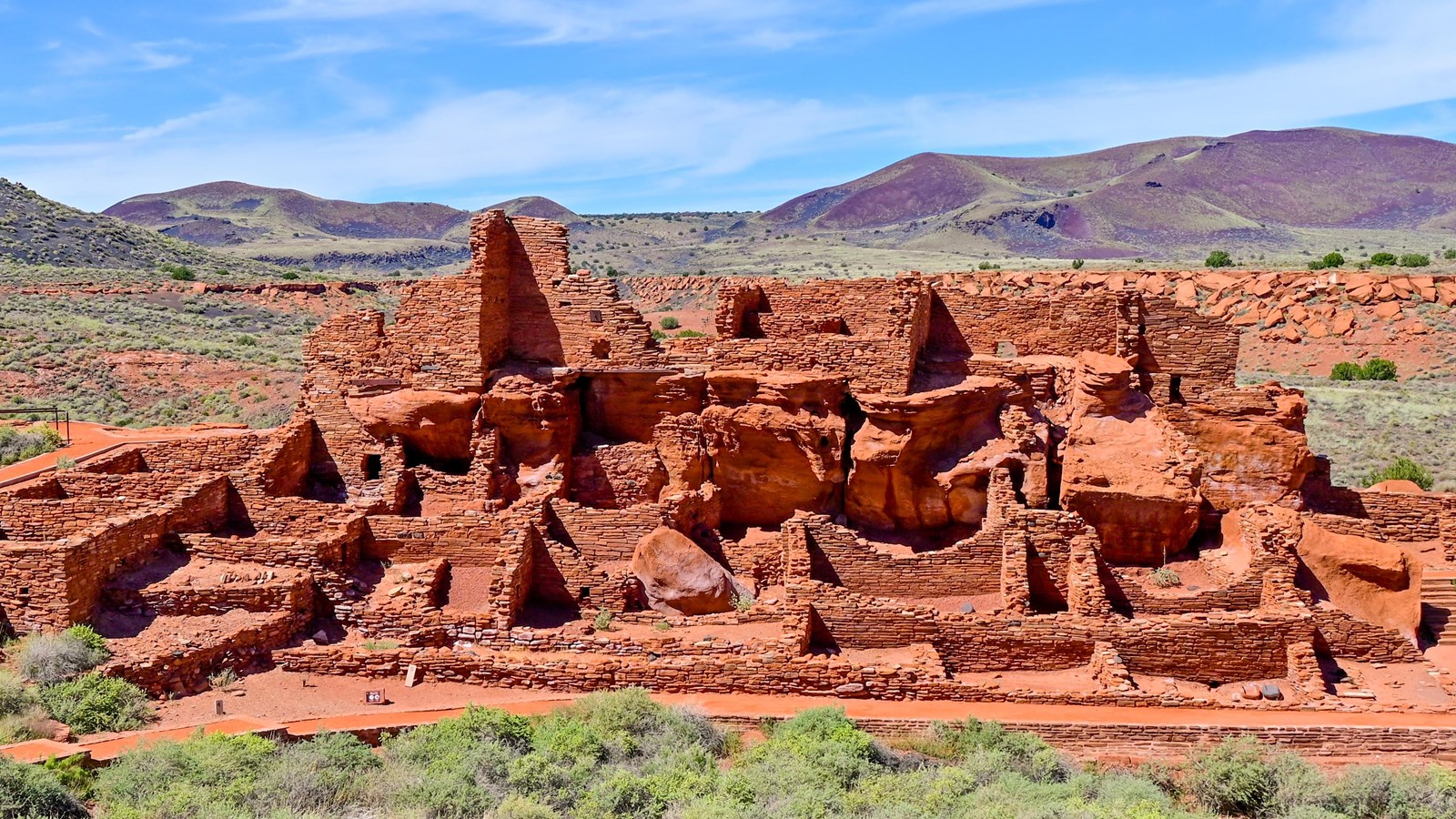Last updated: April 5, 2024
Place
Wupatki Pueblo & Blowhole

Historical/Interpretive Information/Exhibits, Information - Maps Available, Information - Ranger/Staff Member Present, Parking - Auto, Parking - Bus/RV, Picnic Table, Toilet - Flush, Water - Bottle-Filling Station
This 104-room pueblo, complete with ball court and natural blow hole, is located directly behind the Wupatki Visitor Center. It is a 13 mile (20.9 km) drive from the northern entrance of the monument off Highway 89, or 19.5 miles (31.3 km) from the Sunset Crater Volcano National Monument Visitor Center. The parking area has two accessible parking spaces. The path from the parking lot to the Pueblo overlook is paved concrete at a grade of less than 5% and a width of at least 4'. Pets are not allowed on this trail; leashed service animals are ok.
Cultural and Historical Importance
Although it is no longer physically occupied, Hopi believe the people who lived and died here remain as spiritual guardians. Stories of Wupatki are passed on among Hopi, Zuni, Navajo, and perhaps other tribes. Members of the Hopi Bear, Sand, Lizard, Rattlesnake, Water, Snow, and Katsina Clans return periodically to enrich their personal understanding of their clan history. Wupatki is remembered and cared for, not abandoned.
People gathered here during the 1100s, about 100 years after the eruption of Sunset Crater Volcano, gradually building this 100-room pueblo with a community room and ballcourt. By 1182, perhaps 85 to 100 people lived at Wupatki Pueblo, the largest building for at least fifty miles. Within a day's walk, a population of several thousand surrounded Wupatki.
Preservation
The first systematic archeology at Wupatki was done by Jesse Walter Fewkes. Ben Doney, a veteran prospector and pothunter, guided Fewkes to Wupatki pueblo and others which he then photographed and mapped. Fewkes named the large structure Wukoki, but it was given its present name in 1921 by J.C. Clarke, the first custodian of Wupatki.
In the late 1920s as the science of dendrochronology developed, Andrew E. Douglass became interested in recovering beams from the pueblos for dating. Wupatki pueblo at that time contained a number of timbers in good condition. Douglass, aided by Harold S. Colton (founder of the Museum of Northern Arizona), excavated three rooms in 1926-27 to remove some of these beams. Many dates now on file at the Laboratory of Tree Ring Research, University of Arizona, resulted from this work. This was fortunate, because in the early 1930s an illegal whiskey still was operating near the pueblo and the operators were accustomed to digging timbers out of the structure to fire their vats.
During the 1930s and 40s several excavation projects were undertaken at Wupatki pueblo by the Museum of Northern Arizona, and the artifacts uncovered are in the Museum's or the monument's collections. Archeology was a young field of study at that time, and it was felt that in order to gain public support for archeological projects, pueblos such as Wupatki should be restored. In 1933-34 about 37 rooms were excavated and stabilized, the community room was reconstructed, and several rooms were reconstructed and roofed. One room was made into a small museum and headquarters, and two others were converted into living quarters for the custodian and his wife.
Stabilization differs from reconstruction in that it invloved repair of existing wall only. Stabilization efforts include bracing weak walls, remortaring walls where the original mortar has eroded away, and capping walls with mortar to prevent water from seeping into their interior. When the first stabilization work was done in the 1930s, concrete mortar was used. Mortar today is mush like the clay mortar used originally. Stabilization is an on-going project and is necessary to prevent the pueblos from deteriorating further.
In 1952-53 about 18 more rooms were excavated which had been covered with ten to fourteen feet of rubble; the artifacts found from this work are in the Western Archeological and Conservation Center in Tucson. At this time there was a change in National Park Service policy stressing preservation rather than restoration. Because it is impossible to know exactly how a pueblo appeared prehistorically, reconstruction may present an erroneous or unauthentic representation of the structure's original form. Most of the 1933-34 restorations were removed. All the rooms were stabilized at this time, and the drainage system was renovated to prevent erosion. In 1965 the Wupatki ball court was excavated and reconstructed because the few remaining wall segments were inadequate to contain the loose cinders of the wall core.
Current preservation involves annual stabilization of walls, condition monitoring of both the pueblo structure and the surrounding hillsides, invasive plant removal, and trail maintenance.
Thank you for helping us protect this important heritage site by not climbing on walls, leaving all natural and cultural items in their place, and staying on designated trails.
